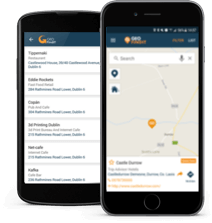Our glossary of terms
Some of the language we use to explain the benefits of GeoDirectory is necessarily specialised. Here we try to define some of the terms to familiarise you with the services our products provide. For insightful content from GeoDirectory visit our Reports page, listen to our series of Webinars or check out some of our latest Blogs.
Boundary data: GeoDirectory records can be broken down and sorted by county, electoral division or townland boundaries.
Electoral division: The Republic of Ireland is divided into electoral divisions based on where people vote. The GeoDirectory database identifies the electoral divisions into which each building falls. This is especially useful for market and demographic analysis. Other databases, including census data, are also broken down according to electoral division.
Flat database: GeoDirectory is supplied in ‘flat files’ which means they contain only records. However, GeoDirectory is highly flexible and can be easily synchronised with interactive applications such as Geographic Information Systems and mapping software.
Geocode: A code or reference number which pinpoints a specific location is known as a geocode. Commonly-used geocodes are those found in the index pages of a city street directory, which allows you to find the page and the square where each street is marked out on the map.
GeoDirectory: The Republic of Ireland’s definitive database of buildings, each matched to a unique postal address, and pinpointed on the map to within a single square metre.
Geographic Information System (GIS): GIS is an interactive computer program capable of assembling, storing, analysing and displaying information which has been identified by location. At its most basic level, a GIS application can be a computerised map. At a more sophisticated level, GIS technology can analyse complex layers of data, match them to a specific locality and predict future trends. The GeoDirectory database will work with most Geographic Information Systems.
Irish Grid: A system of geographic grid references commonly used on the island of Ireland. It was devised by Tailte Éireann and overlaps with the British Grid. For the purpose of the Irish Grid, Ireland is divided into 20 squares each identified by a single letter.
Irish Transverse Mercator: ITM is the new X,Y co-ordinate system for Ireland. It was implemented jointly by the Tailte Éireann and the Tailte Éireann of Northern Ireland in 2001 to synchronise with the newly developed GPS technology. It is more precise than the Irish Grid – though both systems are used in parallel in GeoDirectory.
Tailte Éireann: Ireland’s long-established State-owned mapping agency is also the premier supplier of maps and digital geographic data. Tailte Éireann’s expertise provided the geocodes which allowed GeoDirectory to pin down every building in the Republic of Ireland to within one metre.
Standardised Address: An address which conforms to a single, uniform, national standard is described as a standardised address. Storing addresses in a standardised format makes it easy to manage databases and use direct marketing applications such as mail merge. GeoDirectory provides a standardised address for every residential and commercial property in the Republic of Ireland.
Unique address: Many buildings in the Republic of Ireland are not clearly identified by number or even by street name. GeoDirectory has allocated every residential and commercial property its own unique address, based on an eight-digit identity number. This allows accurate and straightforward analysis and management of address databases.
X,Y coordinates: These are references on the Irish Grid and the Irish Transverse Mercatorwhich are GIS compatible. The X coordinate identifies the exact easterly location, while the Y coordinate identifies the exact northerly location. If the X,Y coordinate for a building is known it can be pinpointed on a large-scale map at the exact spot - within one metre - where the two coordinates intersect.
Tech Specs
Interested in seeing GeoDirectory in action, take a look at our sample data, find out more about our metadata and see what data formats we offer.
Webinars & Events
GeoDirectory are delighted to partner with the Irish Organisation for Geographic Information for a series of monthly webinars. Each webinar brings you indepth and insightful presentations into a current development from the geographical information sector.






